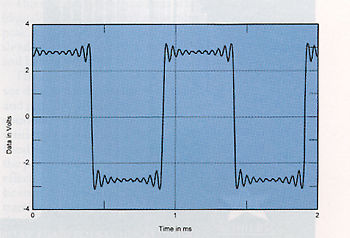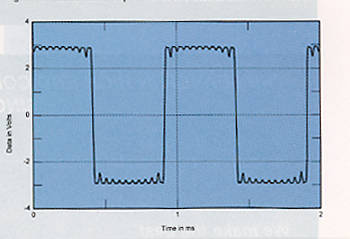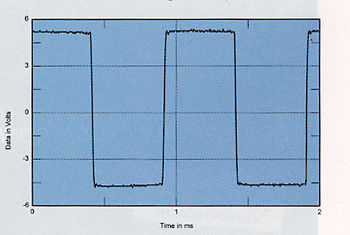| Columns Retired Columns & Blogs |
Can one correlate intersample overs to the square wave phenomenon JA is referring to here? That is, Philips, Wadia, Pioneer's Legato Linear, and Meitner do not "compress" the overs?

Fig.1 Waveform of 1kHz squarewave restricted to 22kHz bandwidth.
Most of the waveform plots we publish show this completely natural overshoot and ringing; and in this sense, looking at the shape of a 0dBFS squarewave reveals nothing new about the product itself. However, while some digital filter chips, such as the Philips designs, exactly reproduce this kind of mathematically correct squarewave, others, such as the common Burr-Brown and NPC chips, chop off the tops and bottoms of the waveform (fig.2). As full-scale squarewaves don't exist in music, this will have no deleterious effect on sound quality. However, all things being equal, it does allow the designer of the digital filter to maximize its low-level mathematical accuracy.

Fig.2 Waveform of 1kHz squarewave restricted to 22kHz bandwidth and reconstructed with NPC digital filter chip.
There is one class of digital processors and CD players, however, that performs quite differently on this test. If their digital filters have been optimized for time-domain performance—Wadia, Pioneer's Legato Linear—they don't suffer from the Gibbs Phenomenon "ringing," and more correctly reproduce all transient-type signals (fig.3). The price to be paid, however, is a premature rolloff at the top of the audioband. The Meitner IDAT even tries to get the best of all worlds by using a DSP-chip-based digital filter for continuous signals. This filter produces a normal squarewave shape, but switches to a filter algorithm optimized for transient performance on signals that are rich in transients.

Fig.3 Waveform of 1kHz squarewave restricted to 22kHz bandwidth and reconstructed with Meitner's digital filter.
The squarewave response doesn't give much clue to sound quality, but it does reveal what aspects of overall performance the designer thought most important.—John Atkinson

Can one correlate intersample overs to the square wave phenomenon JA is referring to here? That is, Philips, Wadia, Pioneer's Legato Linear, and Meitner do not "compress" the overs?